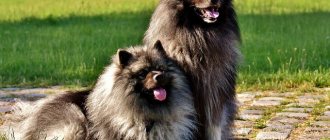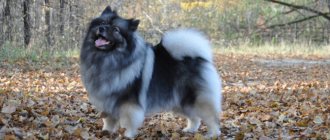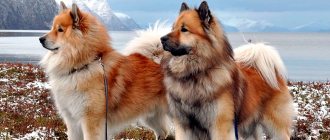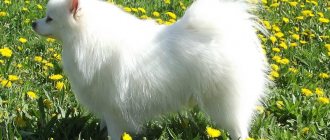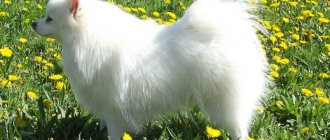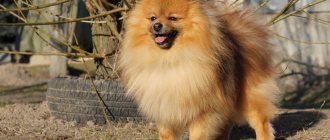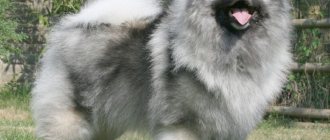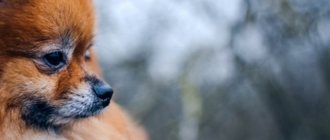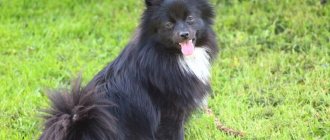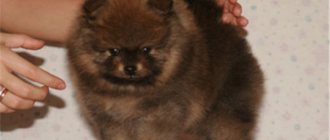History of the breed
The homeland of the Keeshond is Germany.
This species is one of the oldest breeds in the world. The main distribution of Wolfspitz dogs is observed in Germany and Holland, where they have been known for more than 400 years. It was here that these dogs were identified as a separate breed.
The ancestors of the Keeshond are prehistoric peat dogs and lake dogs dating back to the Neolithic. In Central Europe these are the most ancient breeds.
In the distant past, at the very beginning of the history of the breed, its representatives were called “barge dog”.
This is due to the fact that these animals were kept mainly on barges, boats and other vessels. Their duties included catching rodents.
In 1781, the barge dog was renamed Keeshond. During the same period, representatives of the breed gained great popularity. A civil uprising occurred. The revolution was led by Cornelius de Guislar. His favorite pet was a Wolfspitz.
The dog became the emblem of the revolution, a symbol of freedom. But the uprising was defeated. Those people who previously sympathized with Keeshonds and kept them in their homes hastily tried to get rid of their pets, fearing accusations of belonging to conspirators and revolutionaries.
As a result, the number of Wolfspitz catastrophically decreased over a short period of time. The breed was threatened with complete extinction.
The situation was saved by the intervention of Baroness von Hardenbruck. She really liked the friendly “smiling” dogs with wolf-colored fur. Since 1920, she begins work to restore the breed.
For breeding work, purebred Keeshonds had to be found in fishermen's families, far from cities.
Since 1930, the German Spitz has regained popularity, but its population leaves much to be desired. These dogs are still quite a rare species today. In the countries of the former USSR, the Keeshond became known only at the end of the twentieth century.
According to the FCI, Pomeranian Spitz and Keeshond are not independent breeds; they are classified as a single breed, “German Spitz”.
Great Britain and America do not share the opinion of the FCI; in these countries the Wolfspitz was officially recognized as an independent breed and a standard was determined.
Owner reviews
My parents gave me a Keeshond puppy for my 16th birthday. I remember how happy I was then. Now my Larik is already 10 years old. He is a wonderful dog! My children are growing up under his watchful eye. He participates in all their games, despite his advanced age. We are together everywhere: Larry always goes with us even on vacation. He is a full-fledged member of the family.
Lena, 26 years old, Novosibirsk
I have been a breeder of German Wolfspitz dogs for 8 years now. Together with my husband, we are breeding these beautiful dogs. Our kids have scattered all over the world. A more grateful and responsive breed cannot be imagined. These dogs are smart, but simple-minded. They are easy to care for and have good health. This is a great option for a family dog.
Olga, 55 years old, Moscow
Photo: Keeshond
Keeshond (Wolfspitz) breed standard
The Keeshond is a medium-sized breed. The physique is square, tightly knit.
The weight of adults is 18-20 kg. , height about 50 cm. Bitches are slightly inferior to males in both height and weight.
A medium-sized head rests on a strong, not too long, slightly arched neck. It is wedge-shaped and wide at the back of the head.
The ears are triangular in shape, small in size, erect.
Almond-shaped eyes are set slightly askew, dark.
Muzzle of medium length. The stop is not very pronounced. The nose is of medium size. The jaws are strong. Scissor bite. Lips are not drooping.
The croup is wide. The withers are weakly expressed. The back is short, the topline is level. The loin is wide. The stomach is slightly tucked. The chest is deep.
The tail is not too long, curved in a ring over the back. Decorated with lush wool.
The limbs are smooth, muscular, and of medium length. The paws are small, “cat-like”, round in shape. Fingers are arched. The paw pads are thick.
The step is straight and easy.
The skin does not form skin folds.
The coat is long and thick. The hair is straight. There is a dense undercoat. The tail is fluffy, there is a luxurious “mane” collar on the neck, “pants” on the hind legs, and beautiful feathering on the front legs.
The color of the Wolfspitz is “wolfish”, zone-gray. The ears and muzzle are black.
Similar breeds:
- Pomeranian Spitz
- Japanese Spitz
Characteristic
The German Wolfspitz Keeshond is energetic, temperamental, self-confident and independent. Loyal to his owner, whom he may even be jealous of. He is sociable, loves his family, is friendly with children, but is wary of strangers. An excellent watchman.
In childhood, the Wolfspitz is like a hurricane, but as it grows up, it becomes calmer, without losing its cheerful disposition.
Spitz have a great sense of a person and their mood. This quality is used by psychotherapists who have noticed that in their presence, patients make contact much easier.
Maintenance and care
The Keeshond can feel comfortable both in an apartment and in a private house. It is not recommended to keep it outdoors. He is not afraid of frost, but he cannot stay away from people for a long time.
The dog should have its own place in the apartment. Equip it with a bed, buy toys for your pet, and teach it to go there when the command “place” is given. You will also need containers for food and water. Care products etc. of course, a collar with a leash.
If you live in an apartment, be sure to walk your pet twice a day. Wolfspitz loves to be outdoors, so it is recommended to increase the number of walks whenever possible and regularly take him out into nature.
If a Keeshond lives in a private house with an adjacent territory, in the summer he can be in the yard all day, but he needs to arrange a shelter for rest and provide access to the house.
Regarding grooming, in general it is not difficult, but the Wolfspitz’s lush coat requires a lot of attention. Find out exactly what procedures you need to take to care for your dog from the list below:
- Brush the coat 2-3 times a week. During molting period, comb daily. It is recommended to use a brush and slicker for the undercoat. The procedure helps remove dead hair, and thanks to it the skin receives a massage that improves blood circulation.
- Frequent bathing is not necessary; 2-3 procedures per year are recommended. You will need detergents, sprays, and conditioners designed for long-haired dogs. Between scheduled baths, if you need to clean your Wolfspitz's coat, you can use dry shampoo.
- We trim the claws as they grow in with a special nail clipper. Be sure to correct the shape of the claws once a month.
- We clean our ears weekly, while carefully inspecting them for signs of damage, inflammation, and excessive accumulation of earwax. If we notice any of the above, we contact a veterinarian, as these may be symptoms of infection. Another warning sign is an unpleasant odor.
- We wipe our eyes as needed using wet wipes, and also examine them daily.
Keeshond owners recommend using an artificial feeding method. Premium dry food will provide your pet with balanced nutrition with the right amount of minerals and vitamins.
Homemade natural food is also not prohibited, just not leftovers from the master's table. You will need high-quality meat products (the basis of the diet), cereals, low-fat fermented milk products, and vegetables.
The owner must provide balanced natural nutrition and correctly determine the daily allowance. It is also important for your dog to have access to clean, cool water around the clock.
The Keeshond is prone to obesity and has a habit of eating more than it needs. That is why the owner makes sure that the pet does not overeat.
How to buy a puppy
To buy a purebred Wolf Spitz puppy, it is better to contact a professional nursery. There the dogs are kept in the right conditions, and studies are carried out for genetic pathologies. Puppies are usually sold at 2 months, but if the dog is needed for exhibitions, it is better to wait until 4 months. At this age, breed characteristics are better visible. Pedigree Keeshond puppies cost from 20 thousand rubles. The price for show class specimens is higher – 40-50 thousand. If a dog is offered cheaper, it may be without documents or with hereditary diseases.
When choosing a puppy, you first need to pay attention to the living conditions of the animals and the behavior of the mother. It is important to study all documents and veterinary certificates. Puppies should be well-fed, active, and playful. It is necessary to check the thickness of the coat, study the color, bite, and position of the limbs. A healthy puppy has clean eyes, a wet nose, no unpleasant odor, and a soft tummy.
The photographs show what the puppies look like:
An interesting video will complement the characteristics of the breed:
Video: Wolf Spitz (Keeshond). Pros and cons of the Wolfspitz breed
Video: Keeshond. Breed characteristics, care
Video: “Home Zoo” program about Wolfspitz (Keeshond)
The Keeshond is a cheerful, good-natured dog with an attractive appearance. If you give her enough attention and take her out into nature more often, she will become your best friend, loyal and obedient.
Health
The average life expectancy of a German Spitz is 15-16 years.
It mainly depends on the conditions of detention and veterinary care.
The owner must vaccinate the dog according to the established schedule, carry out regular deworming and treatment for skin parasites.
It is recommended to show your Keeshond to specialists at a veterinary clinic annually. Such preventive examinations will help to detect health problems in time.
Treatment at the initial stage is known to be much more effective than fighting an advanced disease.
It is also important that the owner is aware of what diseases his pet is predisposed to. Characteristics of the Wolfspitz are outlined below:
- Epilepsy - accompanied by seizures, convulsions, cannot be treated, but a person, with the help of medications and proper handling of the animal, can control attacks, reducing their number.
- Hypoadrenocorticism is an endocrine pathology.
- Allergies – often occur to food. Therefore, it is important to carefully and gradually introduce new foods into the diet or change the type of dry food.
- Dysplasia – contributes to the development of arthritis, characterized by unbearable pain and lameness.
- Cataracts are an eye disease that severely impairs vision to the point of blindness.
- Knee dislocation is a genetically inherited bilateral pathology.
- Hypothyroidism is a deficiency of circulating thyroid hormones in the Keeshond's blood.
- Progressive retinal atrophy develops in both eyes at once and always leads to complete blindness.
- Diabetes mellitus cannot be completely cured, but requires control, proper diet and medications.
- Obesity comes from overeating, poor nutrition and a sedentary lifestyle. Leads to disruptions in the gastrointestinal tract and cardiovascular diseases.
- Von Willebrand disease develops when there is a defective von Willebrand factor in the blood or a deficiency of it in the blood.
Mating
Spitz are not large, they do not need much space. Owners can carry out the mating themselves, but it is important to register with the nursery in order to receive certified puppies with documents and pedigree.
After puberty ( 8-10 months ), a period of complete physical development of the entire organism must pass. A girl is able to bear healthy offspring only at 2.5 years of age , at 3-4 estrus . The normal cycle is 2 heats per year with an interval of 6-9 months.
It is important for the owner to monitor the girl’s condition in order to track sexual heat based on symptoms. The best time for mating is 13-15 days from the beginning of the cycle. The discharge becomes lighter, the loop loosens, and the mood changes to playful or aggressive.
On the appointed day (after signing the certificates at the nursery), the owners bring the pets together on neutral territory, where the animals can communicate and get to know each other. Experienced females know when to allow mounting. If the girl resists, it is better to postpone mating.
When the male does the mounting, he needs to be held by the lower back, the bitch is held by the head and under the belly. You can't let go while your pets are in the castle. But even without this, the female can become pregnant. Fixative mating is carried out every other day. Pregnancy is monitored at a veterinary center or with tests (after 2 weeks).
Read a detailed article on the topic: “Everything you need to know about breeding dogs: appropriate age, what to do if it doesn’t work out, rules and tips.”
Character
The Keeshond is a friendly, loyal and very cheerful pet. He won't let anyone in the house get bored. At the same time, you can’t call him pestering. The dog sensitively understands when the owners are busy and should not be distracted.
The character of the Wolfspitz could be called ideal, but such a statement is hampered by the stubbornness and willfulness of the representatives of this breed.
The Keeshond is capable of pranks and mischief. All because of playfulness, restlessness and curiosity.
You can control your dog through training. From puppyhood, she must learn the rules of behavior in the house and in public places.
The Wolfspitz is friendly with children. He plays with pleasure, has fun, and plays pranks. Both the child and the energetic Spitz enjoy outdoor games. Parents should teach their children to treat their dog with care and love.
The distant ancestors of the modern Keeshond had an innate hunting instinct. Now the Wolfspitz is not a hunter, but a companion, a pet.
He also has hunter genes in his blood, but they are not so strong and appear extremely rarely.
Therefore, the German Spitz easily gets along in the same house with other pets, especially with their own kind. Can make friends with both a cat and a ferret. Much depends on the dog’s personality and upbringing.
A Wolfspitz will not make an ideal watchdog. He has no aggression towards humans. He, of course, can warn his owners about the arrival of strangers with a loud bark, but he will not attack them.
Distrust of house guests does not last long. The Keeshond, after getting to know each other a little, can start playing; he likes to be the center of attention.
Key facts
Keeshonds are beautiful, intelligent dogs with delightful personalities. They are playful and affectionate, making them ideal family pets. Unlike other northern breeds, Dutchies are relatively easy to train.
Kees are very smart. According to owner descriptions, Keeshonds are rarely annoying, but they will bark as a warning that a stranger is nearby.
The pet will be happy if he is allowed to live in a house with his family, his “pack”. It is best when the dog can enter and leave the house independently, through the doggy door.
The Keeshond can be immediately distinguished from the crowd by its lush coat and characteristic “spectacled” markings. Dark circles draw special attention to their intelligent and lively eyes.
Bred to serve as guards on barges, the animals easily adapt to both small and large spaces. Their compact size makes them an excellent option for families with children.
Furry pooches can stay outside in cold weather, but they need to be provided with adequate shelter. Due to their thick fur, hot, humid climates are not recommended for four-legged pets.
Training and education
The Wolfspitz needs not only physical exercise, but also mental stimulation. Representatives of the breed are smart and have developed intelligence.
Therefore, it is not difficult to teach such a dog a variety of commands, both simple and complex.
The training process doesn't have to be boring. Keeshond does not tolerate monotony, prolonged repetition of the same commands.
The best way to train is through play. Plan your lessons in a variety of ways. Take frequent breaks, during which you repeat already learned commands in the form of a game.
The Wolfspitz owner requires patience, kindness and, of course, consistency. Be sure to reward your pet for success. To do this, always keep your favorite treats with you.
Wolfspitz loves to bark loudly with or without reason. It is recommended to teach him to stop barking on command. Otherwise, conflicts with neighbors cannot be avoided, especially if you live in an apartment in a multi-story building.
Interesting Facts
- The Wolfspitz has the largest dimensions of all types of Spitz; it has preserved as much as possible the original natural appearance of its ancestors.
- In their homeland, the Wolfspitz was called “barge dog”, due to the fact that most of them were kept on barges where they caught rats.
- The Keeshond has a specific gait, it walks as if “on stilts”, all due to the fact that while moving the dog almost does not straighten its hind limbs.
- Keeshonds love to swim and are not afraid of water.
- The Wolfspitz is one of the ten most intelligent breeds in the world.
- Keeshonds are unusually clean; they can wash themselves with their paws, like cats.
- The Wolfspitz is called the “smiling Dutchman”, the fact is that these dogs have a special structure of their muzzle, which creates the appearance of a smile.
Application
Initially, Keeshonds were used as guard dogs: herding livestock and catching rats and mice. The guarding qualities of Wolfspitz dogs are quite high; they have good hearing and a clear bark. With their voices, dogs report the approach of strangers and possible danger. Now the breed serves to accompany the owner, as a faithful and affectionate pet.
In addition to security activities, the Wolfspitz quickly masters sports sciences. This breed shows good results in dog racing and agility competitions. With proper intensive training, an intelligent wolf copes well with guard duty. Keeshond can also be trained to search for people or to work in the field of zootherapy.
Pros and cons of the breed
In the territory of the former countries of the Soviet Union, the Wolfspitz is still a rare species. The price for purebred puppies is quite high.
The Keeshond is not suitable for people who are too busy; he needs communication and attention, as well as long daily walks. Such an energetic dog will not be able to stay locked up all the time; such confinement will have a negative impact on both the psyche and health.
The main advantages of the Keeshond breed:
1. Beautiful exterior. 2. Friendly disposition. 3. Gets along well with other pets. 4. Not afraid of the cold. 5. Sharp mind, developed intelligence. 6. Gets along with children.
Vaccinations
Before deciding on vaccination, consult with the breeder. He should explain when the deworming was carried out and what vaccinations the puppy received. He can also suggest a diagram of these procedures.
The first time deworming medications are given to the puppy is when he is three weeks old. This early age is explained by the fact that infection with helminths sometimes occurs in utero. This procedure is repeated at least 10-15 days later (10-15 days before vaccination).
Important! Select dewormers for small puppies with extreme caution.
Care must be taken when selecting vaccines for puppies
Vaccinations are carried out only on healthy animals. To make sure of this, the body temperature of the puppy or adult is measured two to three days before vaccination. She must:
- be within the established values (for a puppy up to 6 months – up to 39.3 degrees, for an adult dog 38.5; readings from 37.5 to 39 degrees are considered normal);
- be stable throughout the day.
Mandatory vaccines include vaccinations against:
- parvovirus enteritis;
- carnivore plague;
- parainfluenza;
- leptospirosis;
- infectious hepatitis;
- rabies.
In modern veterinary practice, monovalent and polyvalent vaccines are used.
The first are aimed at creating immunity against one disease, others - against several at once.
The latter significantly reduce the time of vaccination, therefore reducing the risk of disease. The vaccination schedule is drawn up individually by the veterinarian.
Polyvalent vaccines speed up the procedure and reduce the risk of disease
Feeding pets
The issue of nutrition for Keeshonds is very important, since they are prone to obesity. Therefore, owners need to carefully monitor their pet’s diet. You can feed the animal with high-quality dry food intended for this type of dog. Feeding should be done twice a day. It is important to follow the instructions on the packaging to ensure you select the correct amount of food.
The issue of nutrition must be approached wisely. Experienced dog breeders recommend following simple rules:
- There should be a strict time interval between meals.
- After a meal, you should not leave the bowl; it is better to hide it away.
- But a container of water should always be ready so that the dog can quench his thirst.
- If you feed your dog prepared food, then you should not offer him food from your table.
- If the animal refuses to eat, then the reason must be identified. Because this can often be a sign of a disease.
- The dog should be accustomed to commands regarding food, so that during walks the food found does not become its food. At your command, the animal must throw the find.
- It is necessary to feed the dog in his absence.
Video review
It is difficult to convey all the beauty and charm of the breed in photographs and short films about Wolfspitz. But it is impossible not to notice the excessive activity of dogs, combined with obedience. And how beautiful fluffy wool looks, painted in different shades of gray. Wolfspitz is a breed of dog for friendship. They are loyal, obedient and energetic. An inquisitive Keeshond puppy instantly puts you at ease and makes you fall in love with his charming eyes. With proper, consistent training, you can get an intelligent, quick-witted Spitz, capable of understanding a person’s mood on an intuitive level.
